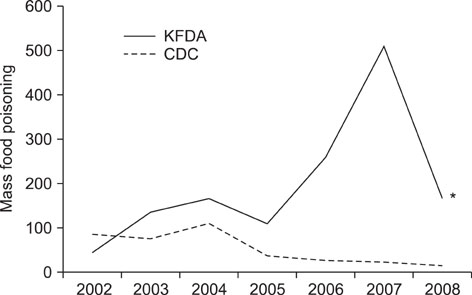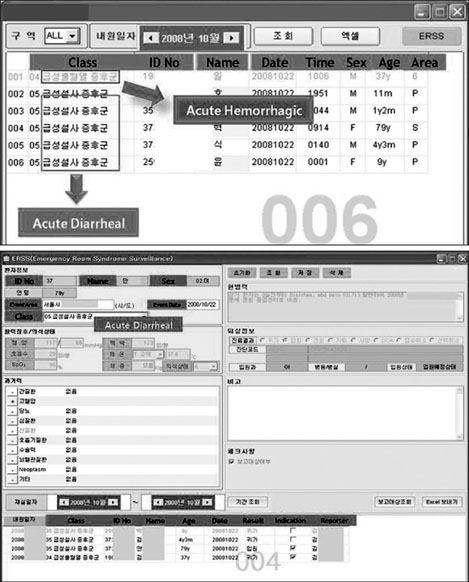Healthc Inform Res.
2010 Sep;16(3):177-184. 10.4258/hir.2010.16.3.177.
Analysis of the Korean Emergency Department Syndromic Surveillance System: Mass Type Acute Diarrheal Syndrome
- Affiliations
-
- 1Department of Emergency Medicine, Asan Medical Center, College of Medicine, University of Ulsan, Seoul, Korea. rufiji@gmail.com
- KMID: 2284530
- DOI: http://doi.org/10.4258/hir.2010.16.3.177
Abstract
OBJECTIVES
This study was designed to compare the data from the emergency department syndromic surveillance system of Korea in detection and reporting of acute diarrheal syndrome (mass type) with the data from the Korea Food and Drug Administration. And to offer fundamental materials for making improvements in current surveillance system was our purpose.
METHODS
A study was conducted by reviewing the number of cases reported as acute diarrheal syndrome (mass type) from the Korean Center for Disease Control and Prevention between June, 2002 and July, 2008. And the data were compared with the number of mass food poisoning cases during the same period, reported from the Korea Food and Drug Administration. The difference between two groups was measured and their transitions were compared.
RESULTS
The emergency department syndromic surveillance system's reports of the numbers of acute diarrheal syndrome (mass type) cases were different from the transition of mass food poisonings, reported by the Korea Food and Drug Administration. Their reports were not accurate and they could not follow the trends of increase in mass food poisonings since 2002.
CONCLUSIONS
Current problems in the emergency department syndromic surveillance system in Korea are mostly related to inaccuracies of daily data reporting system. Manual data input by the reporters could play a big role in such inaccuracies. There need to be improvements in the ways of reporting data, such as automated information transport system linking electronic medical record.
Keyword
MeSH Terms
Figure
Reference
-
1. Sosin DM. Syndromic surveillance: the case for skillful investment view. Biosecur Bioterror. 2003. 1:247–253.2. Anti-Bioterrorism Information Network. Korea Center for Disease Control and Prevention. cited on 2010 Aug 16. Available from: http://bioterrorism.cdc.go.kr.3. Cho JP, Min YG, Choi SC. Syndromic surveillances based on the emergency department. J Prev Med Public Health. 2008. 41:219–224.
Article4. Beitel AJ, Olson KL, Reis BY, Mandl KD. Use of emergency department chief complaint and diagnostic codes for identifying respiratory illness in a pediatric population. Pediatr Emerg Care. 2004. 20:355–360.
Article5. Fleischauer AT, Silk BJ, Schumacher M, Komatsu K, Santana S, Vaz V, Wolfe M, Hutwagner L, Cono J, Berkelman R, Treadwell T. The validity of chief complaint and discharge diagnosis in emergency department-based syndromic surveillance. Acad Emerg Med. 2004. 11:1262–1267.
Article6. Food poisoning statistical system. Korea Food and Drug Administration. cited on 2010 Aug 16. Available from: http://e-stat.kfda.go.kr.7. Caudle JM, van Dijk A, Rolland E, Moore KM. Telehealth Ontario detection of gastrointestinal illness outbreaks. Can J Public Health. 2009. 100:253–257.
Article8. Gangnon R, Bellazzini M, Minor K, Johnson M. Syndromic surveillance: early results from the MARISSA project. WMJ. 2009. 108:256–258.9. Muscatello DJ, Churches T, Kaldor J, Zheng W, Chiu C, Correll P, Jorm L. An automated, broad-based, near real-time public health surveillance system using presentations to hospital Emergency Departments in New South Wales, Australia. BMC Public Health. 2005. 5:141.
Article10. van-Dijk A, Aramini J, Edge G, Moore KM. Real-time surveillance for respiratory disease outbreaks, Ontario, Canada. Emerg Infect Dis. 2009. 15:799–801.
Article11. Irvin CB, Nouhan PP, Rice K. Syndromic analysis of computerized emergency department patients' chief complaints: an opportunity for bioterrorism and influenza surveillance. Ann Emerg Med. 2003. 41:447–452.
Article12. Chapman WW, Dowling JN, Wagner MM. Classification of emergency department chief complaints into 7 syndromes: a retrospective analysis of 527,228 patients. Ann Emerg Med. 2005. 46:445–455.
Article13. Buehler JW, Hopkins RS, Overhage JM, Sosin DM, Tong V. CDC Working Group. Framework for evaluating public health surveillance systems for early detection of outbreaks: recommendations from the CDC Working Group. MMWR Recomm Rep. 2004. 53:1–11.
- Full Text Links
- Actions
-
Cited
- CITED
-
- Close
- Share
- Similar articles
-
- Analysis of Early Results from the Emergency Department Syndromic Surveillance System for Bioterrorism
- Early Aberration Reporting System Modelling of Korean Emergency Syndromic Surveillance System for Bioterrism
- Syndromic Surveillances based on the Emergency Department
- The Applicability and Usefulness of Emergency Department Syndromic Surveillance Using a Computed Data Source for Epidemic Keratoconjunctivitis and Meningitis
- Methods Using Social Media and Search Queries to Predict Infectious Disease Outbreaks





